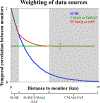Constraining chemical transport PM2.5 modeling outputs using surface monitor measurements and satellite retrievals: application over the San Joaquin Valley
- PMID: 30288162
- PMCID: PMC6166888
- DOI: 10.5194/acp-18-12891-2018
Constraining chemical transport PM2.5 modeling outputs using surface monitor measurements and satellite retrievals: application over the San Joaquin Valley
Abstract
Advances in satellite retrieval of aerosol type can improve the accuracy of near-surface air quality characterization by providing broad regional context and decreasing metric uncertainties and errors. The frequent, spatially extensive and radiometrically consistent instantaneous constraints can be especially useful in areas away from ground monitors and progressively downwind of emission sources. We present a physical approach to constraining regional-scale estimates of PM2.5, its major chemical component species estimates, and related uncertainty estimates of chemical transport model (CTM; e.g., the Community Multi-scale Air Quality Model) outputs. This approach uses ground-based monitors where available, combined with aerosol optical depth and qualitative constraints on aerosol size, shape, and light-absorption properties from the Multi-angle Imaging SpectroRadiometer (MISR) on the NASA Earth Observing System's Terra satellite. The CTM complements these data by providing complete spatial and temporal coverage. Unlike widely used approaches that train statistical regression models, the technique developed here leverages CTM physical constraints such as the conservation of aerosol mass and meteorological consistency, independent of observations. The CTM also aids in identifying relationships between observed species concentrations and emission sources. Aerosol air mass types over populated regions of central California are characterized using satellite data acquired during the 2013 San Joaquin field deployment of the NASA Deriving Information on Surface Conditions from Column and Vertically Resolved Observations Relevant to Air Quality (DISCOVER-AQ) project. We investigate the optimal application of incorporating 275 m horizontal-resolution aerosol air-mass-type maps and total-column aerosol optical depth from the MISR Research Aerosol retrieval algorithm (RA) into regional-scale CTM output. The impact on surface PM2.5 fields progressively downwind of large single sources is evaluated using contemporaneous surface observations. Spatiotemporal R 2 and RMSE values for the model, constrained by both satellite and surface monitor measurements based on 10-fold cross-validation, are 0.79 and 0.33 for PM2.5, 0.88 and 0.65 for NO3 -, 0.78 and 0.23 for SO4 2-, and 1.01 for NH+, 0.73 and 0.23 for OC, and 0.31 and 0.65 for EC, respectively. Regional cross-validation temporal and spatiotemporal R2 results for the satellite-based PM2.5 improve by 30 % and 13 %, respectively, in comparison to unconstrained CTM simulations and provide finer spatial resolution. SO4 2- cross-validation values showed the largest spatial and spatiotemporal R2 improvement, with a 43 % increase. Assessing this physical technique in a well- instrumented region opens the possibility of applying it globally, especially over areas where surface air quality measurements are scarce or entirely absent.
Conflict of interest statement
Competing interests. The authors declare that they have no conflict of interest.
Figures







Similar articles
-
A Bayesian ensemble approach to combine PM2.5 estimates from statistical models using satellite imagery and numerical model simulation.Environ Res. 2019 Nov;178:108601. doi: 10.1016/j.envres.2019.108601. Epub 2019 Jul 25. Environ Res. 2019. PMID: 31465992 Free PMC article.
-
Assessment and statistical modeling of the relationship between remotely sensed aerosol optical depth and PM2.5 in the eastern United States.Res Rep Health Eff Inst. 2012 May;(167):5-83; discussion 85-91. Res Rep Health Eff Inst. 2012. PMID: 22838153
-
Estimating PM2.5 speciation concentrations using prototype 4.4 km-resolution MISR aerosol properties over Southern California.Atmos Environ (1994). 2018 May;181:70-81. doi: 10.1016/j.atmosenv.2018.03.019. Epub 2018 Mar 10. Atmos Environ (1994). 2018. PMID: 30546266 Free PMC article.
-
Global estimates of ambient fine particulate matter concentrations from satellite-based aerosol optical depth: development and application.Environ Health Perspect. 2010 Jun;118(6):847-55. doi: 10.1289/ehp.0901623. Environ Health Perspect. 2010. PMID: 20519161 Free PMC article.
-
Enhancing Models and Measurements of Traffic-Related Air Pollutants for Health Studies Using Dispersion Modeling and Bayesian Data Fusion.Res Rep Health Eff Inst. 2020 Mar;2020(202):1-63. Res Rep Health Eff Inst. 2020. PMID: 32239871 Free PMC article.
Cited by
-
A Bayesian ensemble approach to combine PM2.5 estimates from statistical models using satellite imagery and numerical model simulation.Environ Res. 2019 Nov;178:108601. doi: 10.1016/j.envres.2019.108601. Epub 2019 Jul 25. Environ Res. 2019. PMID: 31465992 Free PMC article.
-
Ambient traffic related air pollution in relation to ovarian reserve and oocyte quality in young, healthy oocyte donors.Environ Int. 2024 Jan;183:108382. doi: 10.1016/j.envint.2023.108382. Epub 2023 Dec 12. Environ Int. 2024. PMID: 38103346 Free PMC article.
References
-
- Al-Saadi J, Szykman J, Pierce RB, Kittaka C, Neil D, Chu DA, Remer L, Gumley L, Prins E, and Weinstock L: Improving national air quality forecasts with satellite aerosol observations, B. Am. Meteorol. Soc, 86, 1249–1261, 2005.
-
- Andrews E, Saxena P, Musarra S, Hildemann LM, Koutrakis P, McMurry PH, Olmez I, and White WH: Concentration and composition of atmospheric aerosols from the 1995 SEAVS experiment and a review of the closure between chemical and gravimetric measurements, J. Air Waste Manage, 50, 648–664, 2000. - PubMed
-
- Appel KW, Napelenok SL, Foley KM, Pye HOT, Hogrefe C, Luecken DJ, Bash JO, Roselle SJ, Pleim JE, Foroutan H, Hutzell WT, Pouliot GA, Sarwar G, Fahey KM, Gantt B, Gilliam RC, Heath NK, Kang D, Mathur R, Schwede DB, Spero TL, Wong DC, and Young JO: Description and evaluation of the Community Multiscale Air Quality (CMAQ) modeling system version 5.1, Geosci. Model Dev, 10, 1703–1732, 10.5194/gmd-10-1703-2017, 2017. - DOI - PMC - PubMed
-
- Bey I, Jacob DJ, Yantosca RM, Logan JA, Field BD, Fiore AM, Li Q, Liu HY, Mickley LJ, and Schultz MG: Global modeling of tropospheric chemistry with assimilated meteorology: Model description and evaluation, J. Geo- phys. Res.-Atmos., 106, 23073–23095, 2001.
-
- Bond TC and Bergstrom RW: Light absorption by carbonaceous particles: An investigative review, Aerosol. Sci. Tech, 40, 27–67, 2006.
Grants and funding
LinkOut - more resources
Full Text Sources
